The Museum Collections
Introduction
I. History and Art Collection
1. Icons of the 14th – 19th centuries
icons of the 14th – 17th century
2. Jewelry art of the 14th – 20th century
jewelry art of the 14th – 17th century
jewelry art of the 18th – 19th century
the european silver 14th - 19th centuries
3. Small-size sculptures (works of metal, wood, bone)
XI – the beginning of the XX century
Small-size sculptures 11th – 17th century
Small-size sculptures 18th – early 20th century
enamel of Troitza masters 15-8th – early 20th century
5.Embroidery, lace, textiles of the 14th - early 20th century
icon and ornamental embroidery
gold and silver lace
6.Painting of the 18th – 21st centuries
painting of the 18th – 19th centuris
painting of the 20th – 21st centuris
II.Manuscripts and old printed books of the 14th – 17th century
IV.Lithography of the 18th – 19th century
V.Numismatics
VI.Medals of the 18th - early 20th century
VIII.Archeology collection
IX. Russian folk and applied and decorative art of the 17th – 21st c.
1. Artistic wood
folk carved and painted wood
wooden toys
house carving of Sergiev Posad
Khokhloma and Gorodets painting
2. Artistic textiles
embroidery and weaving
printed textiles and lace
Russian shawls
folk costumes
folk garments
printed cotton kerchiefs
|
Embroidery and weaving of the 18th – 20th century (p. 2) |
The Novgorod embroidery is presented in a museum by samples from Ustjuzhinsk district. In these embroideries the main place belongs to the image of a female figure. In items of our collection it is present at compositions with a sacred tree of a life, ceremonial scenes of sacrifices, with branches in hands, is represented in the form of a tree-bush or with birds.
The plots which have come to a 19th century from depth of ancient culture of the pre-Christian period, are characteristic and for embroideries of Kargopol district of the Arkhangelsk region. They were executed by very rich on colour techniques “zastil” and a bilateral stitch which here often named the “painting”.
|
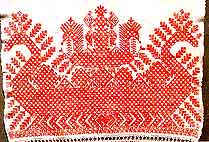
Wedding towel. Fragment. 1911. Novgorod region |
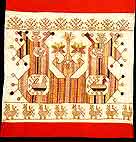
Towel of 19th century. Arkhangelsk region. Cherevkovsk district |

Towel of 19th century.Arkhangelsk region. Kargopol |
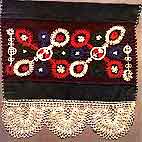
The end of towel. 1884. Torzhok |
Òhe Tver embroidery differs by the big variety of artistic touches and style signs. Local specific features testify to deep stability of traditions of ancient art. The ancient through white stitch most typical for the southeast centers what Staritsa, Torzhok, Tver, Kashin, Korcheva, Kalyazin, for a southern part of Bezhetsk and northeast vicinities of Vesegonsk were concerns widespread receptions of sewing. The Tver embroideries draw attention the rich coloristic variety.
The most archaic graphic motives are one-colour and performs according to ancient tradition strictly by white or red threads. The multi-colour embroideries which were performs mainly woolen and more rare the silk threads, extended basically in a northeast part differs by the big originality. The Rzhev embroideries single out with the original colour scale, the Teblesh and Vesegonskå ones - with the bright sated colour, extraordinary courageous on the contrast combinations.
Òhe Tver embroidery at some similar lines with samples of the pskovo-novgorod type, and also with the Smolensk and Yaroslavl differs the deeply original character. All these embroideries represent a considerable stratum of art culture of Russian people and testifies that the carrier antiquity in a folk art was not only Russian North as was considered earlier, but also and the ancient centers of a midland of Russia, among which the Tver land keep the special place.
|
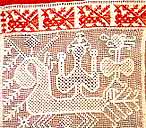
Wedding towel, "long". 1856. Novotorzhsky district |
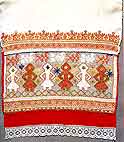
Wedding towel. Fragment. 1900. Bezhetsk |
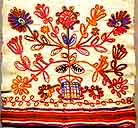
End of the towel. 1900th. Vesegonsk |
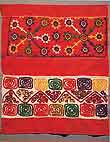
End of the towel. 1878. Rzhev |
The modern embroidery is presented by original decorative products of high art quality. In elegant cloths, towels and other products are skillfully use traditional receptions of sewing and remain lines of national embroidery. Here various versions of the loose guipure with thin developed laces are excellently used. Such most thin interlacing in difficult subject compositions performs images of human figures. These beautiful embroideries differ with big refinement, as for example, from Mihaylov town, the Ryazan region.
Òhe traditional colour “interweave” of Tarussa good hands from the Kaluga region it is extraordinary colourful. Geometrical patterns as well as subject compositions is perform by red, dark blue, yellow, white threads with which the background grid is intertwined also. The ornament of elegant gift products skillfully joins inscriptions. The colour countable smooth known under the name «the Vladimir seam» is created in Mstyora of Vladimir region. A pattern executed by red and dark blue threads as if it is captured along the edges by shaggy "brushes". Separate details of drawing are developed by a small pattern. In unique embroideries such designing are sometimes perform by gold threads. Besides woven scarves made at various industrial complexes of an applied art.
|
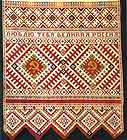
M.N.Gumilevskaja. Towel. 1960. Fragment. Factory of art embroidery of Tarusa, Kaluga region |
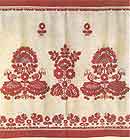
T.M.Shulpina (Dmitrieva). Decorative rug «Girls cast away».1963. Fragment. Factory of the name of N.K.Krupsky. Village Mstyora, Vladimir region |
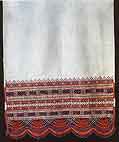
D.A.Smirnova. Towel. 1958. Fragment. Mihaylovsky artel " Toiler", Mihaylov town, Ryazan region |
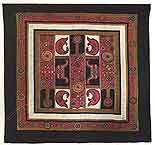
V.I.Zaviskaya. Scarf «Ladle and “rubel”».1964. Moscow |
|


